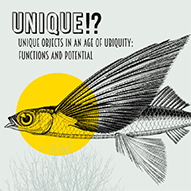
Programme Friday, September 16, 2022
General Reading Room, Central Library![]()
| 9:00 – 9:45 a.m. | To Make Way for the Unique, Know the Ubiquitous Galadriel Chilton, Director of Collections Initiatives, Ivy Plus Libraries Confederation, USA |
| 9:45 – 10:30 a.m. | Copy as a Unique Object – Qualities of the Individual Object Prof. Dr. Ernst Seidl, Museum of the University of Tuebingen, Germany |
| 10:30 – 11:00 a.m. | Coffee Break |
| 11:00 – 11:45 a.m. | From Work Trousers to Jumble of Notes or: A Short (Austrian) Literary History Drawing on Objects |
| 11:45 – 12:30 p.m. | Objects in Action Dr. André Schüller-Zwierlein, University Library of Regensburg, Germany |
| 12:30 – 1:00 p.m. | Summary & Farewell |
| 1:00 – 2:00 p.m. | Lunch |
| 2:15 – 2:45 p.m. | Guided Tour: Exhibition UNIQUE!? Unique Objects in an Age of Ubiquity: Functions and Potential at University Library of Regensburg |
Galadriel Chilton: To Make Way for the Unique, Know the Ubiquitous
A partnership of 13 academic libraries, the Ivy Plus Libraries Confederation’s goal is to efficiently use our resources to create an infrastructure that increases effective management of, and access to, the dynamic collection that underpins the research ecosystem of our institutions.
A dynamic collection is one that includes strategic duplication: To increase bibliographic diversity, libraries acquire enough copies of easily-available print material to meet demand yet avoid excess duplication and collect more unique materials to meet users’ needs (i.e., books from independent presses that due to short publishing runs, etc., are nearly special collections upon publication).
However, just as constructing a building requires an architect’s plans and a strong foundation; so, too does a dynamic collection need a blueprint that includes a shared lexicon and specifications. For example:
- How do 13 unique institutions with different systems and processes come together and create a sustainable structure for collaborative collections that is strengthened by diversity of thought and approach?
- What are our shared definitions for terms such as “strategic acquisition” and “excess duplication” for the partnership?
- What is the minimum number of copies the partnership needs to acquire to meet users’ needs?
- How does the stewardship of a dynamic collection vary by discipline or subject?
In this presentation, the Ivy Plus Libraries Confederations’ Director of Collections Initiatives, Galadriel Chilton, describes how the partnership is finding answers to the above questions through:
- Key governance and communication practices for successful collaboration;
- Data analysis tools and techniques for identifying the partnership’s ubiquitous single part print monographs; as well as
- A pilot coordinated approval plan to acquire ubiquitous content at the partnership level so that local libraries can potentially acquire more unique content needed to fulfill user demand.
Prof. Dr. Ernst Seidl: Copy as a Unique Object – Qualities of the Individual Object
According to popular opinion, the creativity that leads to a unique object and its corresponding copy do not get along very well with each other. For a long time, even in the more recent occidental history of art, it was apparently the case that every universally accepted, successful painter was likely to ruin his reputation by working as a copyist. In those instances, in which copies are made and sold with fraudulent intent, this even constitutes a criminal offence—no matter how well the copyist may know his craft and himself as an artist. However, this view is far too simplistic. The present contribution therefore attempts to accentuate the „unique qualities“ of copies and to shift the perspective on this aspect.
Dr. Bernhard Fetz: From Work Trousers to Jumble of Notes or: A Short (Austrian) Literary History Drawing on Objects
The archival tradition is selective and occasionally brings to light peculiar objects. By using four exemplary objects and object groups, which belonged to prominent Austrian authors and have become museum objects in the meantime, the lecture addresses the relationship between the aura of original objects, being of importance for one’s individual biography, and their corresponding digital representations in the form of virtual exhibitions or digital editions. The imago of famous authors will be discussed as well as questions of research on writing processes. A tattered pair of work trousers, installed and labelled on cardboard by the estate agent Ignaz Hennetmair, a hiking stick of Peter Handke with engravings by the author as well as some of his notebooks, the legendary jumble of notes as an expression of Friederike Mayröcker's writing universe and an aggressively worded handwritten note on the desk of the concentration camp survivor, literary scholar and author Ruth Klüger, who died in 2020, are the exemplary objects. Their physical presence as unique archival and museum objects in the respective work context is up for debate.
Dr. André Schüller-Zwierlein: Objects in Action
Taking the current exhibition of unique items at the University Library as a starting point, the paper challenges the superficial notion of cultural heritage objects and opens up various dimensions in which objects can be seen as acts or actions.
UNIQUE!? Unique Objects in an Age of Ubiquity : Functions and Potential
International Conference
University of Regensburg, September 15-16, 2022
E-Mail: ub.conference@ur.de



